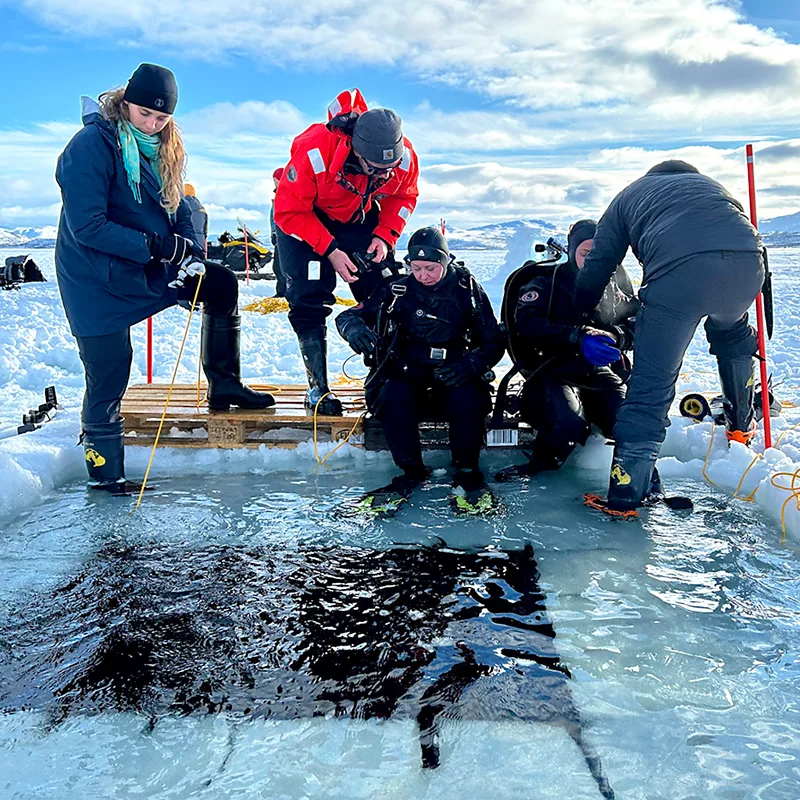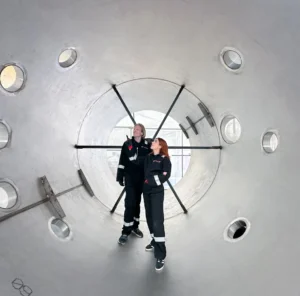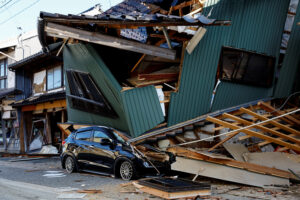Beneath the thick, frozen surface of the Arctic lies a world few have seen—a world encased in ice, with cold waters that remain shrouded in mystery.
In the remote corners of Lapland, northern Finland, a group of dedicated scientists and divers are braving these frozen depths to study how the Arctic environment is evolving. Their mission is to better understand the effects of climate change on these isolated, icy ecosystems.
In this unique location, the surface of a lake is covered by a 70cm-thick (28 inches) layer of ice, creating an icy barrier between the divers and the world below. This frozen expanse is both a challenge and an opportunity, as the divers venture into a frozen world that feels worlds apart from our own. Around a hole cut into the ice, a small group of roughly 20 people gathers, peering cautiously into the inky, black water below.
The cold, almost lifeless waters beneath the ice remain just slightly above freezing—hovering near 0°C (32°F). Despite the seemingly inhospitable environment, these divers are preparing for an experience that is as chilling as it is enlightening. The lake’s frigid waters are not only a test of endurance but offer valuable insights into how Arctic ecosystems are being impacted by rising temperatures.
Among the group of divers is Sophie Kalkowski-Pope, a marine biology graduate from the University of Queensland in Australia. Sophie, along with others in her team, is part of a special ice-diving training program held in this frigid corner of the world. The primary goal is to gain a deeper understanding of how ice-covered bodies of water in the Arctic are changing and how life under the ice survives.
The conditions for divers are extreme. Sophie, like the others, is clad in a dry suit to protect herself from the cold shock that awaits her. Once she enters the water, the sudden contact with the freezing temperatures will be intense, especially on her exposed skin. The cold shock could take a few moments to adjust to, but divers are trained to manage their reactions to avoid panic.
The icy waters in these Arctic regions can be so numbing that even with the aid of thermal clothing and special gloves, divers often struggle to use their hands effectively after just 30 minutes submerged in the cold water. The severe chill makes it difficult to maintain dexterity, so the divers’ movements become slower and more deliberate as they work in the harsh conditions.
However, the challenges do not end there. The dangers of diving in Arctic waters go beyond just the freezing temperatures. Divers face other risks such as restricted visibility, the potential for hypothermia, and the constant threat of ice shifting or breaking. To mitigate these dangers, strict safety protocols are observed at all times.
Safety Protocols for Ice Diving
Given the harsh conditions and potential dangers of ice diving, safety is of utmost importance for the team. Divers are always tethered to the surface using a rope, which ensures that they remain connected to their handlers above. The tethering system allows the team to monitor their progress and provide support if necessary.
In addition to the rope system, a communication method is in place to allow divers to communicate with the surface team during the dive. This is done via a series of signals on the rope, with one tug indicating “all is well,” two tugs signaling “stop,” and three tugs for “come back.” This simple yet effective communication system ensures that everyone involved can stay in constant contact and react quickly if any issues arise.
In case of an emergency, a standby diver is always on hand, fully equipped and ready to jump into the icy water to assist. This additional layer of safety is crucial, as swift action could be required to help a diver who is in distress or facing complications during the dive. Having two holes cut into the ice also provides a critical advantage—two exit points allow divers to quickly reach the surface, minimizing the time spent in the frigid water.
As climate change accelerates, the Arctic is undergoing profound changes. Rising temperatures are having a direct impact on the thickness and extent of ice cover in the region, which in turn affects the ecosystems that rely on this ice. Studying these remote and extreme environments is vital for understanding the broader impacts of climate change and how life in the Arctic is adapting to a changing environment.
Ice-covered lakes like the one in Lapland are important sources of information for scientists. By studying how the ecosystems below the ice respond to warming temperatures, researchers are gaining valuable insights into how the entire Arctic region is evolving. Understanding these changes can help predict future shifts in the Arctic environment and guide conservation and management efforts in the region.
The work of these Arctic divers is part of a growing effort to explore areas that are increasingly difficult to access due to ice melting, shifting, or thinning. As temperatures rise, the window of opportunity to explore these icy depths grows smaller, making every dive all the more important for advancing our understanding of the region.
Despite the challenges and dangers, the experience of diving beneath the Arctic ice is awe-inspiring. The underwater world they enter is an alien environment—one that feels both serene and surreal. With smooth ice forming the ceiling and the vast, dark waters below, divers have the rare opportunity to explore a place few have ever seen.

In these frozen waters, life continues in unexpected ways. Microorganisms and hardy species have adapted to survive in the freezing conditions, and scientists are eager to learn more about how these creatures manage to thrive in one of the harshest environments on Earth. This research could shed light on the resilience of life in extreme conditions, potentially offering insights into other isolated ecosystems on the planet or even other worlds.
The growing interest in Arctic exploration and the study of ice-covered ecosystems is not just about understanding how the Arctic is changing—it’s about learning how these changes will ripple out across the globe. The Arctic plays a crucial role in regulating the Earth’s climate, and understanding how its ecosystems function will help scientists predict broader environmental shifts. By gathering data from these ice-diving expeditions, scientists are building a clearer picture of what the future may hold for the Arctic and the planet.
As the world continues to grapple with the effects of climate change, the work being done by these brave divers is more important than ever. They are diving into the unknown, uncovering secrets that could ultimately help protect the planet and its ecosystems. Every dive into these icy waters is a step closer to understanding the rapidly changing Arctic—a world on the front lines of climate change.
Arctic region continues to warm at alarming rates, researchers are braving extreme conditions to better understand how this frozen world is changing. Ice diving has become a vital tool for scientists studying the rapidly melting ice caps and the delicate ecosystems beneath the frozen surface. In Lapland, Finland, a group of divers is undergoing training to prepare for research expeditions in both the Arctic and Antarctic, where they will venture into freezing waters to document the ongoing effects of climate change.
This unique form of diving, where divers submerge beneath layers of ice, presents a series of challenges that are different from traditional diving in temperate waters. The divers are training in the remote region of Kilpisjärvi, located 400 km north of the Arctic Circle, where the conditions are harsh, and the frozen landscape offers a perfect setting for ice diving training. The trainees, already experienced divers in warmer climates, are now taking their skills to a new level.
For some, like marine biology graduate Sophie Kalkowski-Pope, the initial fear of diving beneath the ice gives way to the beauty of the experience once submerged in the frigid water. “Once you get in the water, you realise what a beautiful environment you’re in and you calm down a bit,” she says. Despite the natural trepidation that comes with diving in such extreme conditions, Kalkowski-Pope and other divers are eager to master this technique, which will enable them to join scientific diving expeditions in the Arctic and Antarctic.
One of the greatest challenges in ice diving is the risk of entanglement. The lines of rope that connect divers to the surface, allowing them to stay tethered and return safely, can become tangled with submerged branches, logs, or other debris. Even a diver’s own equipment, such as fins or tanks, can cause complications under the ice. These obstacles can prevent divers from safely returning to the surface, which makes proper preparation and caution essential during every dive.
Training in these conditions prepares the divers for even greater dangers in the Arctic and Antarctic. In these remote regions, divers face not only the physical challenges posed by cold, darkness, and isolation, but also unexpected encounters with Arctic wildlife. Large seals sometimes gather around the dive holes, blocking the divers’ exit from the water. These creatures can complicate the diver’s attempts to surface, adding another layer of difficulty to their expeditions.
Despite these challenges, divers undergo rigorous training and preparation. For example, Kalkowski-Pope, like her fellow trainees, meticulously checks her equipment before entering the water. With the final adjustments complete, she prepares herself for the cold shock of the Arctic waters, which will be an intense but essential part of her experience.
The Arctic has long been an area of concern for climate scientists. The region is warming at a rate that is four times faster than the global average, contributing to rapid changes in the environment. Satellite data has shown that sea ice covering the Arctic Ocean has been shrinking at an alarming rate, decreasing by approximately 13.2% per decade since monitoring began in 1979. This dramatic reduction in ice coverage is a key indicator of the broader impacts of climate change.
Ice diving plays an important role in the study of these changes. By venturing into the frozen depths, scientists can directly observe and document the conditions of underwater Arctic ecosystems. This hands-on approach provides critical information about how the ice is thinning, the movement of the ice sheets, and the temperature and salinity of the water. Ice dives also allow researchers to monitor the health and distribution of plant and animal life in the region, providing a clearer picture of how climate change is affecting the Arctic’s fragile ecosystems.
As the polar regions continue to melt, there is an urgent need for scientists trained in ice diving techniques. Edd Stockdale, the coordinator of the Finnish Scientific Diving Academy and the lead instructor of the ice diving course, explains the growing demand for scientists who can monitor these changes. “There’s probably only a few hundred people in the world who can do polar base diving work at the moment. The polar areas are melting. We need scientists who are able to monitor what’s happening,” Stockdale says.
In addition to studying the physical changes to the ice itself, ice diving provides an opportunity to learn more about the organisms that call these icy waters home. The Arctic and Antarctic are host to unique species that have adapted to life in extreme cold. Some of these species are visible during ice dives, offering a rare glimpse into ecosystems that are not easily accessible.
Scientific diving has already revealed significant changes in the ecosystems beneath the ice. In 2017, Professor Alf Norkko and his team at the University of Helsinki discovered notable changes in the seafloor life under the Antarctic ice. They found a dramatic increase in the abundance of life in the region, with higher levels of chlorophyll and plant compounds deposited on the seabed. This was due to thinner ice that allowed more sunlight to penetrate the water, thus increasing the availability of food for marine creatures such as starfish, sea spiders, and worms.
These findings highlight the complex relationship between ice thickness, light penetration, and the availability of food in the Arctic and Antarctic. The thinning ice has altered these ecosystems in unexpected ways, causing shifts in the abundance and types of organisms found in these areas. The data gathered by ice divers like Kalkowski-Pope will be crucial in monitoring how these ecosystems continue to evolve in response to a warming world.
The importance of ice diving in climate research cannot be overstated. By conducting repeated dives in the same areas over extended periods, researchers are able to track long-term changes in Arctic ecosystems. For example, a 25-year study of kelp forests off the coast of Svalbard, an Arctic archipelago, revealed how rising temperatures have altered the composition of seaweed in these important ecosystems. Divers involved in the study made repeated visits to the same sites to document these changes and assess the health of the kelp forests over time.
As the Arctic continues to warm, the need for ice divers trained in scientific research becomes more pressing. These divers are the ones who can gather firsthand data from beneath the ice, helping scientists better understand how ecosystems are adapting to a rapidly changing environment. Their work is vital for creating more accurate models of how the Arctic will continue to evolve in the coming decades.
The efforts of these brave ice divers are providing critical insights into the effects of climate change in the Arctic. As the ice continues to melt, the knowledge gained from these expeditions will help scientists predict future shifts in the region’s ecosystems and contribute to our understanding of how global warming is affecting the planet. By documenting these changes firsthand, ice divers are playing a crucial role in advancing our knowledge of the Arctic and its delicate, shifting ecosystems.
As the demand for ice divers grows, the importance of training skilled professionals to monitor the Arctic and Antarctic becomes more evident. These divers will continue to be on the front lines of climate change research, collecting the data that will help shape the future of our planet.
Scientists are increasingly relying on ice diving to collect data about the region’s changing ecosystems. In the frigid waters beneath the ice sheets, researchers from various fields are coming together to study the environmental shifts taking place beneath the surface. These expeditions are critical for understanding the impacts of climate change, but the dangers of ice diving are not to be underestimated.
The British Antarctic Survey’s Rothera Research Station recently reported that icebergs are striking the seabed off the West Antarctic Peninsula more frequently, due to shrinking sea ice. These collisions cause significant damage to marine life, scouring the ocean floor and creating devastating scars that wipe out nearly all organisms in their path. This phenomenon underscores the growing importance of research divers who are training to explore these frozen waters, providing essential data about the consequences of a warming planet.
Scientific diving in the Arctic requires more than just skilled divers—it demands a multidisciplinary approach. Professor Alf Norkko, a marine researcher, emphasizes that it’s not enough for just one expert to dive into the icy depths. “We need a team that includes marine biologists, chemists, and physicists,” says Norkko. “Only then can we understand the full scope of the physical and biological processes occurring in these ecosystems.” By combining expertise across fields, researchers are able to develop a comprehensive picture of how the Arctic’s ecosystems are evolving.
Such fieldwork, however, is not without risks. “It’s dangerous. You can’t make any mistakes,” warns Finnish explorer Pata Degerman. He compares ice diving to cave diving, noting that the ice above the diver acts as a ceiling, and there are no simple escape routes. Divers must rely on safety lines and clear communication with their team members on the surface to ensure their safety throughout the dive.
Before venturing into the freezing waters, divers don special protective clothing to shield themselves from the extreme cold. Thermal undergarments are worn beneath dry suits, and divers wear gloves and neoprene hoods to cover their head and neck. Despite this protective gear, divers face challenges, as their hands lose dexterity within minutes in the icy water.
The diving team at Kilpisjärvi, a remote training location in Finland, works in pairs to descend into the water. While tethered to safety lines, they are able to communicate with surface tenders through the ropes, which function as a lifeline. This communication is vital, as divers must signal their status at regular intervals. If there is no response from the surface after a signal, emergency protocols are enacted to ensure the diver’s safety. Standby divers are always ready to respond, entering the water if necessary to assist in emergencies.
A common issue divers face is malfunctioning regulators, the equipment that delivers air from the tanks. The freezing water can cause moisture in the regulator to freeze, leading to a “free flow” event, where air continuously rushes into the diver’s mask. This makes breathing difficult and requires immediate action, either by switching to backup equipment or relying on a dive buddy to share air and return safely to the surface.
Despite the high risks, ice diving remains a crucial part of research in the Arctic. Professor Norkko, who has led numerous polar expeditions, emphasizes that careful preparation and risk management are key to success. “I’ve never had an accident on any of my expeditions,” he says, attributing his safety record to proper training and a thorough understanding of the risks involved.
Among the potential dangers in polar diving are cold shock and flooding of dry suits, especially in Antarctica’s saltwater environments. The water in these regions can dip to -2°C (28°F), increasing the risk of hypothermia. Norkko explains that the thinner ice and greater variability in water temperature pose unique challenges for divers in these regions.
Another challenge Arctic divers face is dealing with local wildlife. Seals, which are often found near dive holes, can block a diver’s exit from the water, making it impossible to return to the surface. “You can’t get past a 300 kg seal,” Norkko jokes, but in reality, this is a serious obstacle. To mitigate the risk, divers always ensure there are at least two exit holes available for each dive.
While remote technologies like robots and remotely operated vehicles (ROVs) are becoming increasingly important in Arctic research, human divers still play a critical role. RODs are limited in that they can only capture data from what is directly in front of them, potentially missing valuable information. “An ROV can’t adjust its path or explore areas of interest based on what it observes,” explains Rodd Budd from New Zealand’s National Institute of Atmospheric Research. “Human divers, however, can take a wider view and react to their surroundings.”
Moreover, divers cause less disturbance to the environment than ROVs, which generate noise and shine bright lights that can interfere with the natural behavior of Arctic wildlife. Divers, on the other hand, can interact more subtly with the environment, allowing for more precise observations without disrupting the delicate ecosystems below the ice. According to Perry Brandes, a diver from Florida, “Many animals actually look at us divers. There’s an interaction between us.”
The drive for Arctic research is fueled by the urgency of climate change. As the polar regions continue to warm, scientists like Norkko are racing against time to gather the data needed to understand the impact of these changes. “Climate change is progressing at such a rate that decisions are sometimes made without the best available scientific knowledge,” says Norkko. “We need to keep science at the forefront.”
However, the allure of adventure also plays a role in motivating these researchers. “There is an element of adventure that drives us,” says Norkko, describing the thrill of fieldwork in such remote and extreme environments. Despite the dangers, the opportunity to explore the dark world beneath the ice and contribute to our understanding of climate change keeps scientists returning to these frozen regions.
Ice diving in the Arctic provides invaluable insights into the region’s rapidly changing ecosystems. By studying the seabed, marine life, and ice thickness, divers can track the ongoing effects of climate change and better predict the future of the Arctic. As these expeditions continue, the data collected will help shape our understanding of the planet’s evolving climate and contribute to efforts to mitigate the impacts of global warming.
Through dedication and risk-taking, ice divers are playing a vital role in preserving and documenting the Arctic’s changing environment. While technology continues to advance, the human touch in these perilous environments remains irreplaceable.










